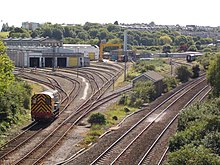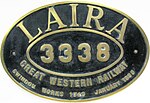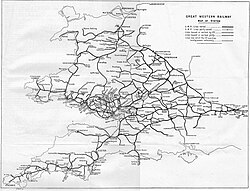Laira Traction and Rolling Stock Maintenance Depot
 Looking south from Laira Flyover | |
 | |
| Location | |
|---|---|
| Location | Plymouth, United Kingdom |
| Coordinates | 50°22′55″N 4°06′20″W / 50.3819°N 4.1055°W |
| OS grid | SX503557 |
| Characteristics | |
| Owner | Great Western Railway |
| Depot code |
|
| Type | Diesel, HST |
| History | |
| Opened | 1901 1931 Enlarged to replace Millbay shed 1962 Rebuilt for diesels 1981 Rebuilt for HSTs |
| Original | Great Western Railway |
| Pre-grouping | Great Western Railway |
| Post-grouping |
|
Laira Traction and Rolling Stock Maintenance Depot is a railway traction maintenance depot situated in Plymouth, Devon, England. The depot is operated by Great Western Railway (GWR) and is where their fleet of Class 802 InterCity Express Trains and remaining Castle Class trains are overhauled. Other trains visit for daily servicing including some operated by CrossCountry.
After sixty years as a steam depot, servicing locomotives used on the Exeter to Plymouth line that runs past the shed as well as local lines, diesels started to arrive in 1958. A diesel depot opened in 1962 and was expanded in 1981 to accommodate the High Speed Trains.
The depot code 'LA' is used to identify rolling stock based there.
History
[edit]Steam shed
[edit]Laira was the location of the temporary terminus of the South Devon Railway from 5 May 1848 when a small engine shed would have been provided. With the completion of the line to Plymouth Millbay railway station on 2 April 1849 a new shed was provided there and the facilities at Laira dismantled, although it remained a junction for the branch line to Sutton Harbour which was mixed gauge for the use of the Plymouth and Dartmoor Railway.
The Great Western Railway, which had amalgamated with the South Devon Railway on 1 February 1876, a new engine shed opened at Laira in 1901[2] on a site inside a triangle of lines formed by the main line, Sutton Harbour branch, and a curve that was mainly used by London and South Western Railway trains to reach their terminus at Plymouth Friary.[3] A sewerage treatment facility and poor ground conditions constrained the site of the shed to the north west corner of the triangle (near Lipson Junction) . It was adjacent to the Embankment Road with the estuary of the River Plym just the other side of the road. The shed was a 185 ft (56 m) brick roundhouse with a 65 ft (20 m) turntable in the middle. 28 lines radiated from the turntable, one for access and the remainder for stabling locomotives. Loocmotives approached from the east (Laira Junction) passing a coaling stage.[4]
A small railway station known as Laira Halt was opened on the adjacent main line on 1 June 1904 but closed again on 7 July 1930.[5]
Initially Laira was only used for goods locomotives but after the passenger locomotive shed at Millbay closed in 1924 it became very crowded. In 1931 a new 210 ft (64 m) long and 67 ft (20 m) wide shed with four tracks was brought into use just south of the original roundhouse, funded by a government loan under the Development (Loan Guarantees and Grants) Act 1929 (20 & 21 Geo. 5. c. 7). This became known as the 'Long Shed' or 'New Shed'.[6] At the same time additional sidings were laid near the coaling stage (which was doubled in length) and a second track connected to give a separate exit route from the roundhouse. The new shed was built over part of the area previously used by the sewerage treatment facility. A new line connected Laira Junction with Mount Gould Junction (the southern point of the triangle of lines surrounding the shed. This line became known as the 'Speedway' and allowed locomotives to turn on the triangle rather than on the turntable inside the roundhouse.[7]
During World War II a covered extension was added on the south side of the coaling stage to give an additional place to refuel locomotives.[7] In 1947 some steam locomotives were converted to burn oil rather than coal. Oil tanks were installed alongside the siding to the south of the Long Shed.[8]
Diesel shed
[edit]
Warship Class diesel-hydraulic locomotives started to appear in 1958 and were at first accommodated in the Long Shed alongside steam locomotives until the diesel maintenance depot had been finished.[6] The Laira marshalling yard alongside Embankment Road was closed in 1958 to make room for carriage sidings and a new diesel shed, which was fully opened on 13 March 1962, although parts had been in use since 1960.[9]
Laira was designed for the servicing and heavy maintenance of the diesel-hydraulic locomotives favoured by the Western Region of British Railways, the first of the region's purpose designed large diesel depots. It also handled the local diesel electric shunter and DMU fleets, although servicing of the latter was done initially at Belmont sidings at Millbay.[9]
The diesel shed was in reinforced concrete and comprised three adjoining buildings. The servicing and maintenance building that covers roads 1–4 is on the western side of the shed; number 1 road is equipped with a wheel lathe and lifting jacks for bogie changes. The central building was the Heavy Maintenance Shed; engines can be removed and repainting undertaken on the two roads, numbers 5 and 6. The final three roads were another servicing shed on the eastern side of the site.[6] Beside this was a small covered area with fuelling points outside in the yard, supplied by a 45,000 gallon fuel tank.[9] A small group of buildings behind the shed house stores and a workshop for shed equipment.[8] Carriage washing takes place south of the shed at Mount Gould.
After the withdrawal of steam from the area in 1964, the roundhouse was closed on 13 June 1965 and the area used for additional siding space.[10][2][11] This area was later modernised and fenced off in readiness for servicing the Nightstar Channel Tunnel sleeper coaches, but the proposed service from Plymouth to Paris Gare du Nord never materialised.[8]
On 30 September 1981 a new shed, 240 m (790 ft) long was opened on the site of the smaller servicing shed on the east side of the site. This can accommodate the eight coaches and two Class 43 power cars of a High Speed Train set.[6] An additional covered track was later added in preparation for the proposed Nightstar services.[8]
After the replacement of High Speed Trains on London services, one road in the shed was leased to Hitachi to maintain the Class 800 and Class 802 'InterCity Express Trains' (IETs) that replaced them. A number of Class 43s continued to be based at Laira to operate four-coach services to Penzance and Cardiff Central. In Edinburgh, the depot at Craigentinny was no longer able to maintain CrossCountry's Class 43s as the space was needed by Hitachi for IETs so the 12 power cars and 5 sets of coaches were transferred to Laira.[12] CrossCountry will withdraw its Class 43s by October 2023 when their lease ends.[13] Great Western Railway has started to reduce the number of its Class 43-powered services in December 2022 with the aim of withdrawing most of them by December 2023. The space freed will allow them to move the maintenance of all their Class 802s to Laira.[14][15]
Historic allocation
[edit]Up to the 1960s Laira had an allocation that consisted of a wide variety of Great Western Railway motive power, including 4073 'Castle' Class and 6000 'King' Class express passenger locomotives. The following lists give summaries for various years.
| Type | 1929[16] | 1934[17] | 1950[18] | 1959[18] |
|---|---|---|---|---|
| 2-8-0 | 1 × 2800 Class 5 x 3000 'R.O.D.' Class |
4 × 2800 Class 1 x 3000 'R.O.D.' Class 1 x 4700 Class |
1 × 2800 Class 2 x 2884 Class 1 x 4700 Class 1 x WD 2-8-0 Class |
2 × 2800 Class 2 x 2884 Class 1 x 4700 Class |
| 4-6-0 | 10 × 4000 'Star' Class | 10 × 4073 'Castle' Class 8 x 4900 'Hall' Class 8 x 6000 'King' Class |
3 × 1000 'County' Class 1 x 4000 'Star' Class 18 x 4073 'Castle' Class 9 x 4900 'Hall' Class 10 x 6000 'King' Class 2 x 6800 'Grange' Class 2 x 6959 'Hall' Class 4 x 7800 'Manor' Class |
3 × 1000 'County' Class 11 x 4073 'Castle' Class 5 x 4900 'Hall' Class 9 x 6000 'King' Class 5 x 6800 'Grange' Class 2 x 6959 'Hall' Class 3 x 7800 'Manor' Class |
| 2-6-0 | 3 × 2600 'Aberdare' Class 5 x 4300 Class |
3 × 2600 'Aberdare' Class 4 x 4300 Class |
3 × 4300 Class | 4 × 4300 Class |
| 2-6-2T | 1 × 3100 Class 3 x 4500 Class |
3 × 3150 Class 2 x 4400 Class 3 x 4500 Class 2 x 4575 Class |
3 × 3150 Class 2 x 4400 Class 5 x 4500 Class 5 x 4575 Class 1 x 5100 Class |
1 × 4500 Class 7 x 4575 Class 3 x 5100 Class |
| 0-6-0 | none | none | 1 × 2251 Class | none |
| 0-6-0T | 5 × 850 Class 6 x 1076 Class 2 x 1813 Class |
6 × 850 Class 2 x 1076 Class 1 x 1361 Class 2 x 1854 Class 1 x 2021 Class 2 x 6400 Class 1 x 5700 Class |
4 × 1361 Class 1 x 2021 Class 21 x 5700 Class 7 x 6400 Class 1 x 9400 Class |
3 × 1361 Class 1 x 1600 Class 8 x 5700 Class 6 x 6400 Class 3 x 9400 Class |
| 4-4-0 | none | 5 × 3300 'Bulldog' Class | none | none |
| 0-4-2T | none | none | none | 2 x 1400 Class |
| Diesel | none | none | none | See below |

The depot was designed to maintain and service the Western Region of British Rail's diesel-hydraulic locomotives. It became strongly associated with the 'Western' Class. The first 14 of these were delivered new to Laira in 1961 and 1962. They were transferred to other depots after a few months but Laira received a fresh allocation in 1964 and by October 1971 the whole fleet of 74 locomotives were based here.[19] Withdrawals started in 1973 and the last were withdrawn in 1977.[20]
By this time British Rail Class 50 diesel-electric locomotives had taken over many of their duties. These were later given warship names in the same manner as the first diesel hydraulics. A fleet of DMUs was also stationed here for operating the branch lines in Devon and Cornwall.[6]
Since the Privatisation of British Rail the allocation has largely consisted of Class 43 power cars for High Speed Trains along with some Class 08 shunting locomotives. The DMUs in Devon and Cornwall were based at Cardiff Canton TMD for several years, but in December 2007 Laira had an allocation of two-car Class 150 and single-car Class 153 DMUs.[21] After a while these were transferred to a reopened Exeter Traction Maintenance Depot.[22]
| Type | 1959[23] | 1974[24] | 1988[25] | 2010[26] |
|---|---|---|---|---|
| Main line | 3 × Class 22 5 x Class 41 4 x Class 42 |
12 × Class 25 11 x Class 46 10 x Class 50 54 x Class 52 |
6 × Class 37 26 x Class 43 30 x Class 50 |
30 × Class 43 |
| Shunting | 2 × Class 03 6 x Class 08 |
2 × Class 03 7 x Class 08 |
13 × Class 08 | 3 × Class 08 |
| DMU | 5 × Class 101 3-car 3 x Class 116 3-car 2 x Class 118 3-car 6 x Class 119 3-car 1 x Class 119 2-car 1 x Class 120 2-car 2 x Class 122 1-car 1 x Class 122 DTS |
9 × Class 101 2-car 4 x Class 108 2-car 2 x Class 118 3-car 3 x Class 118 2-car 1 x Class 121 1-car 3 x Class 122 1-car 2 x Class 121 DTS |
none |
Servicing
[edit]In addition to repairs and overhauls of the trains allocated to the Laira, the depot undertakes daily serving on other classes of train. In 2022 these were[12]
- Allocated to Laira:
- Allocated to other depots
During 2023 both Class 43 fleets were run down but Class 802s were allocated to Laira.[14][13]
Shed codes
[edit]
The following shed codes have been used to identify locomotives allocated to Laira:
| LA | Great Western Railway | |
|---|---|---|
| 83D | British Railways | from 1949 |
| 84A | British Railways | from 1963 |
| LA | British Rail | from 1973 |
Named locomotives
[edit]Locomotives named after Laira depot have been:
| Image | Name | Locomotive | Company | Class | Name carried | Notes |
|---|---|---|---|---|---|---|

|
Laira | 3338 | GWR | Bulldog | 1900-1930 | 4-4-0 steam locomotive. Renumbered 3326 in 1912.[27] |

|
Pride of Laira | 43179 | BR | Class 43 | 1991-2017 | Named during a depot open day.[8][28] |
| Laira Diesel Depot | 08644 | GWR (First) | Class 08 | 2015- | [29] | |
| Pride of Laira | 08641 | GWR (First) | Class 08 | 2017- | [29] | |

|
Laira Diesel Depot | 43184 | CrossCountry | Class 43 | 2023 |
References
[edit]- ^ "The all-time guide to UK Shed and Depot Codes" (PDF). TheRailwayCentre.com. 5 May 2006. Archived from the original on 17 December 2013. Retrieved 26 August 2016.
{{cite web}}: CS1 maint: unfit URL (link) - ^ a b Smith, Martin (1995). An Illustrated History of Plymouth's Railways. Caernarfon: Irwell Press. ISBN 1-871608-41-4.
- ^ Baker, S.K. (4 January 2024). Rail Atlas Great Britain & Ireland. Oxford Publishing Company. ISBN 978-0-86093-553-7.
- ^ Roach, Michael (2017). "Laira Shed, Plymouth (part 1)". British Railways Illustrated. Vol. 27, no. 3. pp. 96–105.
- ^ Oakley, Mike (2007). Devon Railway Stations. Wimbourne: The Dovecote Press. ISBN 978-1-904349-55-6.
- ^ a b c d e Laira '91, InterCity Laira (1991)
- ^ a b Roach, Michael (2018). "Laira Shed, Plymouth (part 2)". British Railways Illustrated. Vol. 27, no. 4. pp. 142–149.
- ^ a b c d e Fisher, Alex (2017). "Pioneering Laira". Railways Illustrated. No. 178. pp. 56–62.
- ^ a b c Reed, Brian (1975). Diesel-Hydraulic Locomotives of the Western Region. Newton Abbot: David and Charles. pp. 87–94. ISBN 0-7153-6769-2.
- ^ Roach, Michael (2018). "Laira Shed, Plymouth (part 3)". British Railways Illustrated. Vol. 27, no. 4. pp. 220–227.
- ^ Cooke, R A (1979). Track Layout Diagrams of the GWR and BR WR: Section 12, Plymouth. Harwell: R A Cooke.
- ^ a b Walmsley, Ian (October 2022). "40 years unbeaten". Modern Railways. pp. 42–48.
- ^ a b "CrossCountry HSTs to bow out this year". Modern Railways. April 2023. p. 10.
- ^ a b "GWR HSTs to go in December". Modern Railways. January 2023. p. 98.
- ^ "Class 802 maintenance moves to Plymouth as quest for better availability goes on". Railway Gazette. 24 April 2023. Retrieved 27 April 2023.
- ^ Harrison, Ian (1984). Great Western Railway Locomotive Allocations for 1921. Upper Bucklebury: Wild Swan Publications. p. 23. ISBN 0-906867-21-5.
- ^ Pocock, Rev. Nigel; Harrison, Ian (1987). Great Western Railway Locomotive Allocations for 1934. Didcot: Wild Swan Publications. p. 39. ISBN 0-906867-34-7.
- ^ a b Bolger, Paul (1983). WR. BR Steam Motive Power Depots. Shepperton: Ian Allan. pp. 37–39. ISBN 0-7110-1311-X.
- ^ Clarke, David; Jennison, John (2007). Diesels in depth: Westerns. Ian Allan. pp. 61–64. ISBN 978-0-7110-3250-7.
- ^ Clarke & Jennison 2007, p. 86.
- ^ Fleet and Lineside News, Rail Magazine, 16 January 2008
- ^ Marsden, Colin J (2010). Rail Guide (2010 ed.). Hersham: Ian Allan. pp. 45–48. ISBN 978-0-7110-3457-0.
- ^ Harris, Roger (1985). The Allocation History of BR Diesels and Electrics (2nd ed.). Bromsgrove: Roger Harris.
- ^ BR Locoshed Book (1975 ed.). London: Ian Allan. 1975. ISBN 0-7110-0641-5.
- ^ Morrison, Brian, ed. (1988). British Rail Motive Power Combined Volume (1988 ed.). London: Ian Allan. ISBN 0-7110-1776-X.
- ^ Marsden, Colin J. (2010). Rail Guide (2010 ed.). Hersham: Ian Allan Publishing. pp. 45–57. ISBN 978-0-7110-3457-0.
- ^ Reed, P.J.T. (1954). The locomotives of the Great western Railway (Part 7). Railway Correspondence and Travel Society. p. 30.
- ^ Marsden, Colin J. (2018). "TOPS numbered diesel classes". Modern Railways Illustrated - Loco Directory. Key Publishing. p. 83.
- ^ a b Marsden 2018, p. 40.
Further reading
[edit]- Hunt, John (6–19 May 1998). "From 'Warships' to HSTs". RAIL. No. 330. EMAP Apex Publications. pp. 30–35. ISSN 0953-4563. OCLC 49953699.

